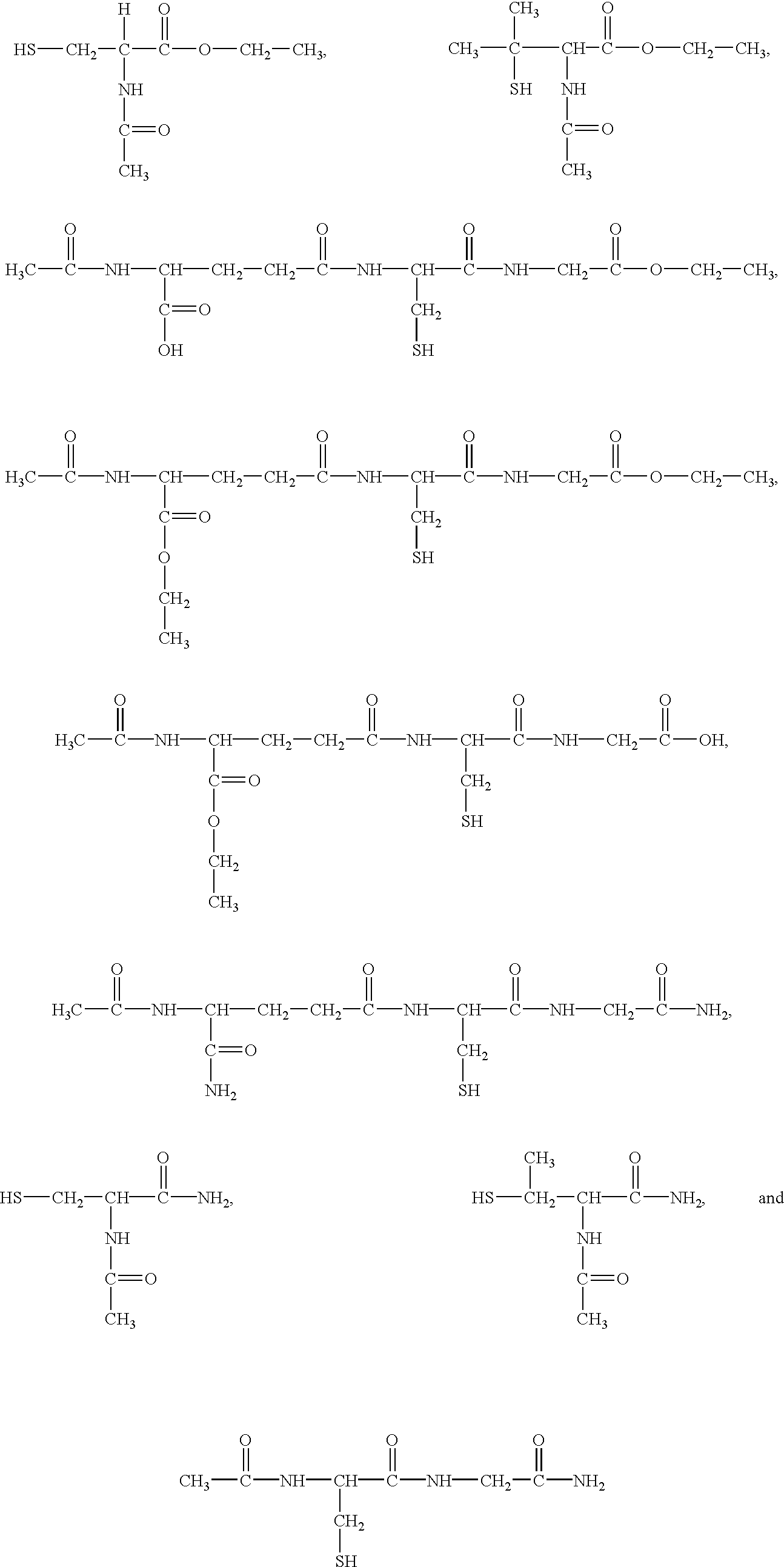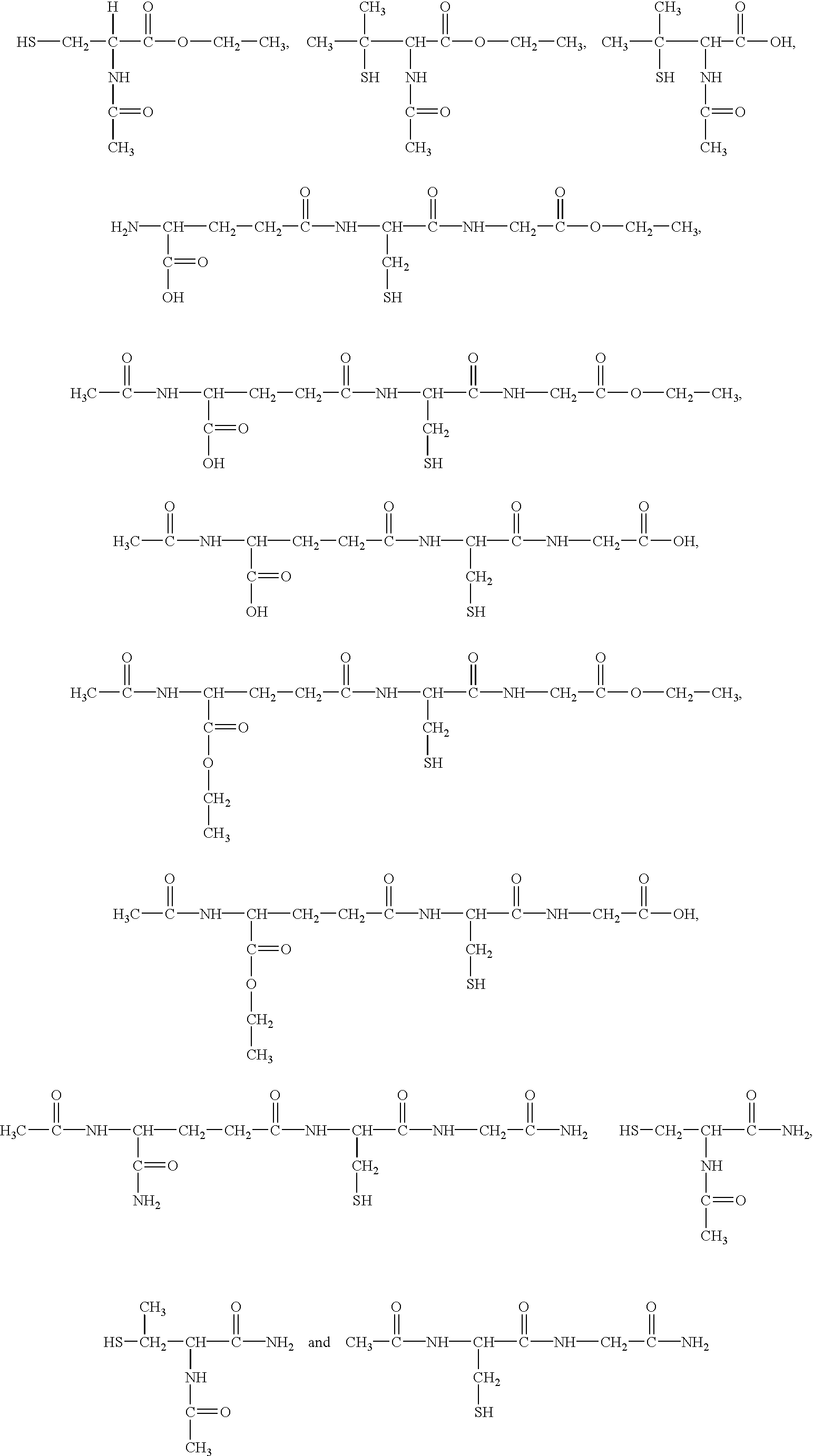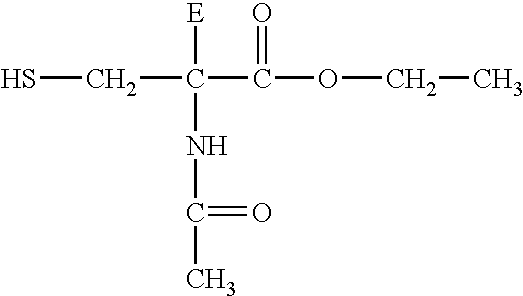Brain targeted low molecular weight hydrophobic anti oxidant compounds
a low molecular weight, anti-oxidant technology, applied in the direction of peptide sources, metabolic disorders, applications, etc., can solve the problems of increasing the number of toxic free radicals, cell death, accumulation of oxidation damage,
- Summary
- Abstract
- Description
- Claims
- Application Information
AI Technical Summary
Benefits of technology
Problems solved by technology
Method used
Image
Examples
example 2
Synthesis of N-acetyl .beta.,.beta.-dimethyl Cysteine Ethyl Ester or N-acetyl-penicillamine Ethyl Ester (Compound B)
[0140] N-acetyl .beta.,.beta.-dimethyl cysteine (2.6 mmol) was added in portions to a cooled (2-8.degree. C.) solution of 2 ml thionyl chloride and 10 ml absolute ethanol. The resulting mixture was refluxed at 40.degree.0 C. for 1 hour and then the volatiles were removed in vacuo. The residue was dissolved in 10 ml of water and was extracted twice with 20 ml of methylene chloride. The extract was dried under vacuo. The title compound was crystallized from a methanol-water solution (1 / 100, fraction 40-60.degree.) in 25% yield.
[0141] The resulting product has the following characteristics:
[0142] (a) Melting point of 180.degree. C.
[0143] (b) Thin layer chromatography in n-butanol / acetic acid / water (4 / 1 / 4) was carried out and the Rf value was Rf=0.66. The Rf value of the reactant, N-acetyl .beta.,.beta.-dimethyl cysteine is 0.88.
[0144] (c) Nuclear Magnetic Resonance (NMR) ...
example 3
Synthesis of N-acetyl Glutathione Amide (Compound I)
[0151] Ammonia gas was bubbled through absolute dry ethanol at -70.degree. C. (dry ice with acetone), for 10 minutes. N-acetyl glutathione ethyl ester (compound G), 350 mg (1 mmol) was added to the cooled ethanol / ammonia solution and ammonia was continued to bubble through the solution for additional 10 minutes. Then, the solution was corked and was left at room temperature. After 16 hours, the flask was opened and access of ammonia and the ethanol were evaporated under reduced pressure. The product was lyophilized. The yield was 84%.
[0152] The resulting product has the following characteristics:
[0153] (a) Thin layer chromatography in n-butanol / acetic acid / water (4 / 1 / 4) was carried out and the Rf value was Rf=0.71.
example 4
Synthesis of N-acetyl Cysteine Amide (Compound J)
[0154] Ammonia gas was bubbled through absolute dry ethanol at -70.degree. C. (dry ice with acetone), for 10 minutes. N-acetyl cysteine ethyl ester (compound A), 163 mg (1 mmol) was added to the cooled ethanol / ammonia solution and ammonia was continued to bubble through the solution for additional 10 minutes. Then, the solution was corked and was left at room temperature. After 16 hours, the flask was opened and access of ammonia and the ethanol were evaporated under reduced pressure. The product was lyophilized. The yield was 98%.
[0155] The resulting product has the following characteristics:
[0156] (a) Thin layer chromatography in n-butanol / acetic acid / water (4 / 1 / 4) was carried out and the Rf value was Rf=0.70. The Rf value of the reactant, N-acetyl cysteine ethyl ester is 0.91.
[0157] Alternatively, a solution of 20% piperidine (4 ml) in 16 ml DMF was added to Fmoc Rink amide AM resin (2 gram; 1.1 mmole amide) and the reaction was al...
PUM
| Property | Measurement | Unit |
|---|---|---|
| molecular weight | aaaaa | aaaaa |
| miscibility properties | aaaaa | aaaaa |
| oxidative stress | aaaaa | aaaaa |
Abstract
Description
Claims
Application Information
 Login to View More
Login to View More - R&D
- Intellectual Property
- Life Sciences
- Materials
- Tech Scout
- Unparalleled Data Quality
- Higher Quality Content
- 60% Fewer Hallucinations
Browse by: Latest US Patents, China's latest patents, Technical Efficacy Thesaurus, Application Domain, Technology Topic, Popular Technical Reports.
© 2025 PatSnap. All rights reserved.Legal|Privacy policy|Modern Slavery Act Transparency Statement|Sitemap|About US| Contact US: help@patsnap.com



